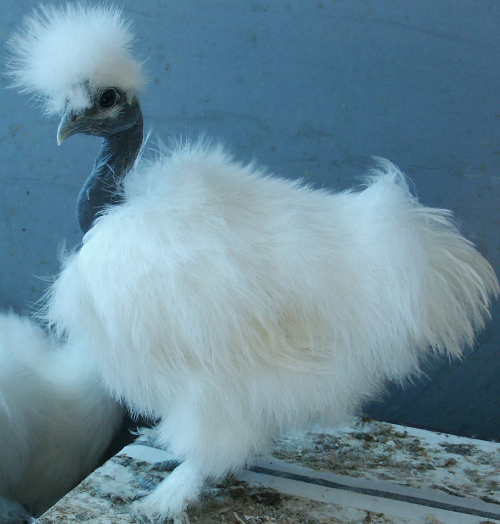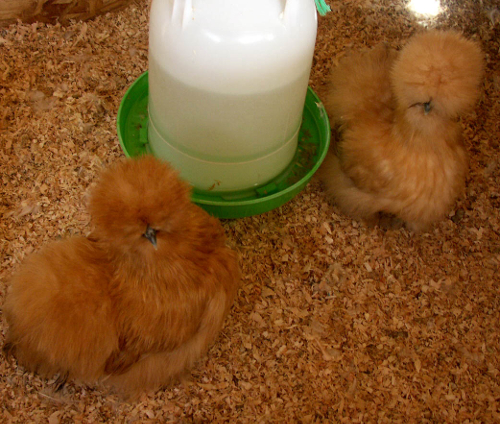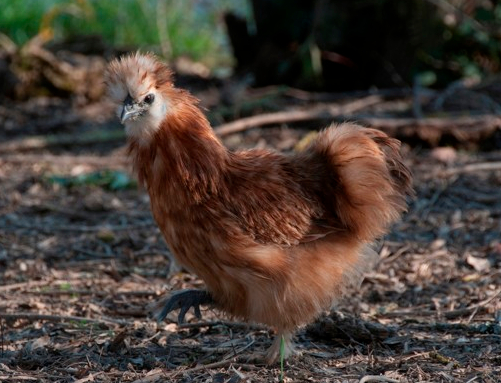Silkie colours.

In my opinion, coloured Silkies are among the most beautiful birds in the poultry world. Their striking colours and beautiful patterns are a sight to behold. It is in the last few years that I have developed an appreciation for them and the challenge in breeding them.
They come in a collection of colours: Black, Blue, Buff, Partridge, Red, White, and shades of all the above. Although for show purposes, variations do not apply.
There are five standardised colours in the UK. White, black, blue, gold and partridge. Cuckoo/Splash or A.O.C Silkies can only be entered into the non-standard Silkie class at shows.
Silkies appear in two distinct varieties: bearded and non-bearded. Bearded Silkies have an extra muff of feathers under the beak area that covers the earlobes. They also are separated according to colour. Colours of Silkie recognised for competitive showing include black, blue, buff, grey, partridge, and white.
Alternative hues, such as cuckoo, lavender, red, and splash also exist. The standards of perfection call for all Silkies to have a small walnut-shaped comb, dark wattles, and turquoise-blue earlobes. In addition to these defining characteristics, Silkies have five toes on each foot.
How many colours of Silkies are there?
There are 10 colours available but not all are recognised and can be shown.
For a gallery of Silkie and showgirl chicken images.
The colour of a Silkie chicken's feathers is also affected by its environment. For example, if a Silkie chicken is raised in a cold environment, its feathers may be darker than if it were raised in a warm environment.
No matter what colour they are, Silkie chickens are all beautiful and unique birds. They are a popular breed of chicken for their gentle temperament, fluffy feathers, and docile nature.
White Silkies:
White Silkie colour genetics - c/c or I/I on any other colour. In Australia, Silkies tend to be c/c, or recessive white. The dominant white gene needs to be introduced from another breed, such as white leghorn.
Naked neck Silkies, usually know as Showgirls, are not currently an official Silkie variety in the ABA, or APA standards. The naked neck is acquired by breeding a turken to a Silkie. The offspring are then bred back to a Silkie for several generations to acquire a Silkie chicken with a necked neck.
Below: A white Showgirl.

I have only ever seen them in white. Take a look at the white Silkie in depth.
Black Silkies:
This year I am focusing on the black variety. I am working on achieving a jet black colouring. My main goal is focusing on the male rather than the female and hope to achieve a smaller com, nice short back, tight wings and medium crest
Black Silkies colour genetics - eb/eb S or s+ (or both in males) Pg/Pg Ml/Ml and other melanisers
OR - E/E S or s+ and other melanisers
OR - ER/ER S or s+ and other melanisers.
Below: A black Silkie.

Roosters get a bit of gold or silver in their hackles at about 1.5 years of age as they are rarely on extended black.
Blue/Splash Silkies:
Blue colour genetics - Any of E or ER or eb s+ or S (S/s+ roosters are possible) Pg/Pg Ml/Ml Bl/bl+ and recessive melanisers.
The hardest part about breeding blue Silkies is getting lighter (versus too dark) shades.
My blues have the Andalusian gene. This is a great gene because (when bred correctly) you can hatch blue, black, or splash babies.
I have 2 breeding pens. They consist of 1 splash rooster and blue hens and 1 blue rooster and splash hens. Our foundation stock is a wide gene pool so we have many different varieties to work with. This combination will result in blue or splash offspring
Silkie chickens blue breeding chart:
Blue X Blue = 50% Blue, 25% Black , 25% Splash
Blue X Splash = 50% Blue , 50% Splash
Blue X Black = 50% Blue, 50% Black
Black X Black = 100% Black
Splash X Black = 100% Blue
Splash X Splash = 100% Splash
Partridge Silkies:
This year I am focusing on achieving the black breast on the males.
Partridge Silkie colour genetics - eb/eb s+ Pg/Pg (Cha/Cha)
The common fault of partridge silkies having a black crest can be attributed to the Cha (Charcoal) gene. It is an autosomal, incompletely dominant gene.
In America the partridge colour is based on gold, with the addition of Mh.
Grey Silkies:
Grey Silkie colour genetics - eb/eb S S pg+/pg+ or Pg/pg+ (Cha/Cha)
Once again, the undesirable black crest can be attributed to the presence of Cha.
Buff Silkies:
Buffs is one of my favourite coloured Silkie varieties. There are many challenges with breeding this colour, but that is what makes it even more intriguing. We have shown our buffs during the fall season and have done well at shows.
Below: A buff Silkie.

Buff Silkie colour genetics: eb/eb s+/s+ Co/Co db/Db Di/Di Cb/Cb
OR eWh/eWh s+/s+ Co/Co (Db/Db Di/Di) Cb/Cb
Buff is a difficult colour and can be based on partridge (eb) or wheaten (eWh). On eb based buffs its very hard to breed out the black, while on eWh the birds can tend to be white under colour. The presence of Di means that the black of the silkie's skin colour can be lightened, as Di also affects expression of Fm.
Red Silkies:
Red Silkie colour genetics - BANTAM eb/eb s+/s+ Pg/Pg Mh/Mh Db/Db or Db/db+ and recessive black.
Below: A red Silkie.

STANDARD eWh/eWh Pg/pg+ or pg+/pg+ Mh/Mh Db/Db and recessive black
I believe there are some people working on red Silkies in Australia. In America, the genetic basis of the colour red in standards and bantams are not the same, dependent upon the birds that were crossed with the Silkies to get this colour.
Lavender Silkies:
Lavender Silkie colour genetics - eb/eb s+ or S (rooster can be S/s+) Pg/Pg Ml/Ml lav/lav and recessive black
I think it also depends which colour you use to get the lavender, for example birds that have been bred to black birds will be split for E or ER depending upon the genetics of the black bird.
Cuckoo Silkies:
CUCKOO colour genetics - Any of eb, E, or ER s+ or S (S/s+ rooster) Pg/Pg Ml/Ml B/B or B/-(hens) and recessive melanisers.
Below: A Cuckoo Silkie. All be it with the wrong comb.

I get numerous requests from people looking for "show quality" cuckoo Silkies. IMO, there are none yet although a few breeders are getting very close.
The cuckoo Silkie is not a recognised variety and there are a few serious breeders working to improve them overall. Currently, the obvious faults and areas of improvement are: red combs, light skin colouring, light eyes, overall type and confirmation.
Cuckoos are a fun gene to work with. It is a sex-indicating trait. Meaning that depending of how it is bred, you can tell males from females. Barred females can only have 1 copy of the barred gene while barred males can have 2 copies of the barred gene.
Barring is defined by "B" which resides on the Z chromosome. Male have two Z sex chromosomes and the female has one Z and one W sex chromosome. There is no barring gene on the W chromosome so females can have only one. A male with 2 copies is represented as (B,B).
A male with one copy is represented as (B, b+) where lower case b+ indicates a lack of the barring gene. A male with no barring is represented as (b+, b+). The female has one long chromosome and one short chromosome. The barring gene is on the long chromosome and not the short one, so therefore a female can have only one copy of the barring gene (always). A female with barring is represented as (B, _).
A female without barring is represented as (b+, _). The underscore indicates her short chromosome lacks the location of that gene.
When a barred female (B,_) is crossed with a non-barred male, (b+, b+) results in all the male offspring being barred and the females are non-barred. That's why the male cuckoo is so important. I get numerous requests from people looking for pullets, however, the key to breeding all cuckoos is the male. When a barred male, (B, B) is crossed with a non-barred female, (b+, _), all the chicks will be barred.
Paint Silkies:
Paint Silkie colour genetics - eb/eb s+ or S Ml/Ml maybe Mh/Mh dominant white action, recessive melanisers, sometimes with addition of blue.
Silkie genetics work like all other poultry colour genetics. The exception is that not every colour is accepted as standard. If you want to breed Silkies, I recommend studying the breed closer and when you decide on a variety, focus on it specifically. There are only 7 recognised colours of Silkies; buff, blue, black, splash, partridge, Gray, and of course white.
If you like competition, raise the white variety.
If you want to be different, raise the blue/black/splash varieties as these are the only colours that can be 'interbred.'
If you are a masochist, raise buffs as there is a lot of culling involved.
If you are a die hard for punishment, raise partridge as this is one of the hardest patterns and colours to get right.
Greys are a patterned bird; blues are essentially solid coloured.
Grey is partridge with silver rather than gold. The hardest part about grey is avoiding autosomal red.
Chicken colours chart
